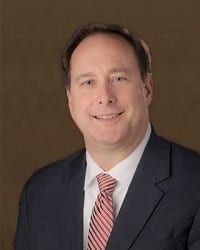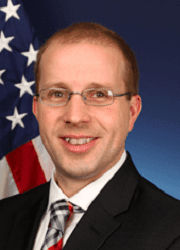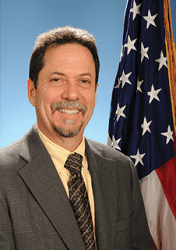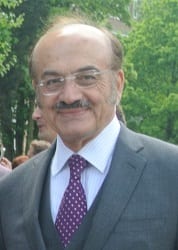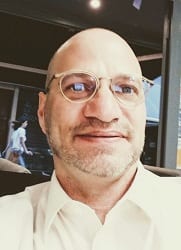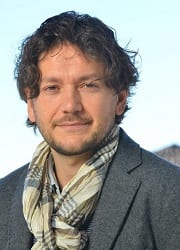Robert Lightfoot
President of LSINC Corporation, Former Acting NASA Administrator
Topic: Becoming a Risk Leader
Abstract: In today’s ever changing world with new technology, how do we adjust our risk acceptance thinking? Striking the appropriate balance between “we’ve always done it that way”, which often came from a hard earned lesson, and embracing something new, along with the associated risk it may bring, takes leadership. Understanding the key aspects of “risk management” and “risk leadership” will help decision makers as they face the opportunities and challenges associated with using new technology within their current risk environment
Biography: Robert Lightfoot is President of LSINC Corporation. He is responsible for leading innovative strategy assurance and product development to help clients achieve mission success. His extensive knowledge in managing a federal agency through times of significant change allows him to develop strategies and eliminate barriers that can impact necessary change for any organization. Lightfoot is the former Acting Administrator of the National Aeronautics & Space Administration (NASA). His permanent position at NASA Headquarters was Associate Administrator, the agency’s highest-ranking civil service position. He previously was director of NASA’s Marshall Space Flight Center in Huntsville, AL, one of NASA’s largest field installations, which plays a critical role in NASA’s space operations, exploration and science missions. He spent much of his Marshall career in rocket engine testing and space shuttle propulsion office. He also served as director of the Propulsion Test Directorate at NASA’s Stennis Space Center in Mississippi. After Stennis, two years were spent at NASA Headquarters focused on strategies for the shuttle return to flight following the Columbia tragedy, then initial transition and retirement efforts for shuttle infrastructure. Lightfoot received a bachelor’s degree in mechanical engineering from the University of Alabama where he is a Distinguished Departmental Fellow for the Department of Mechanical Engineering, a College of Engineering fellow, and served on the Mechanical Engineering Advisory Board. He was inducted into the State of Alabama Engineering Hall of Fame in 2010. He received numerous awards during his NASA career, including the Presidential Rank Award for Distinguished Executives, the highest honors attainable for federal government work, in 2006, 2010 and 2016.
Larry Leopard
Deputy Dir., Engineering Directorate, NASA Marshall Spaceflight Center
Topic: Why are some aerospace professionals reluctant to introduce/accept wireless technology and what are you doing about it?
Abstract: As wireless technologies and commercial applications of these technologies improve/increase, the speaker will attempt to explore reasons why some parts of the aerospace community is slower to adopt. It will also offer a personal perspective and possible ideas on how wireless technology leaders/advocates can speed up their efforts breaking through the roadblocks of acceptance. We live in a world where the risk of new technology implementation vs reward trade is often considered unacceptable by those making final decisions.
Biography: Larry Leopard is deputy director of the Engineering Directorate at NASA’s Marshall Space Flight Center in Huntsville, Alabama. He was appointed to the post in June 2016. As deputy director, Leopard helps oversee Marshall’s largest organization. The Engineering Directorate includes more than 1,200 civil service and 1,100 contractor personnel engaged in the design, testing, evaluation and operation of hardware and software associated with space transportation, spacecraft systems, science instruments and payloads now in development at Marshall. The directorate provides critical support to NASA’s Space Launch System Program, which is managing the construction and testing of America’s new, heavy-lift rocket. Leopard previously was director of the Engineering Directorate’s Space Systems Department from 2014 to 2016, and served as its deputy director from 2011 to 2014. From 2008 to 2011, he was deputy manager of the Engineering Directorate’s Propulsion Systems Department. He was appointed in 2008 to the Senior Executive Service, the personnel system that covers most of the top managerial, supervisory and policy positions in the federal executive branch. Following his selection to NASA’s Senior Executive Service Candidate Development Program in 2006, he completed developmental assignments at NASA Headquarters in Washington, in Marshall’s Space Shuttle Propulsion Office, and at United Launch Alliance’s Delta II and IV Manufacturing and Assembly Plant in Decatur, Alabama. Leopard joined NASA and Marshall in 1990, serving in progressively more responsible technical and leadership positions supporting a variety of NASA programs and projects, including space shuttle propulsion elements; the Space Shuttle Main Engine Technology Test Bed; Rocket-Based Combined Cycle propulsion technology; Fastrac 60K engine; ISS payloads, ISS Environmental Control and Life Support Systems and research facilities; Small Satellite technology demonstrations; and multiple science instruments. His aerospace engineering career began as a propulsion engineer at Martin Marietta of Huntsville, supporting Marshall’s Propulsion Systems Laboratory from 1988to 1990. He has received numerous NASA awards, including the Medal for Outstanding Leadership in 2007 and 2011; a Medal for Exceptional Achievement in 1997 for leading the Integrated Propulsion Technology Demonstrator team; multiple Center Director’s Commendations; and numerous group achievement and special service awards. In 1993, he was awarded the Silver Snoopy, the NASA astronaut corps’ award to those who have made significant contributions to the success of NASA’s human spaceflight missions.
Marshall Smith
Director Cross-Program Systems Integration, Exploration Systems Division, NASA
Topic: NASA’s Human Exploration Systems – SLS, Orion, EGS and Gateway
Abstract: Space Policy Directive 1, released in December 2017, calls for NASA to lead an innovative and sustainable program of exploration with commercial and international partners to enable human expansion across the solar system, including the return of humans to the Moon for long-term exploration and utilization followed by human missions to Mars and other destinations. NASA’s implementation of SPD-1 focuses on eight Strategic Principles, including fiscal realism, leveraging commercial and international partnerships, architectural openness, and continuity of human spaceflight. These principles inform a synergistic path back to the lunar surface, leveraging research and sustainable capabilities demonstrated on the International Space Station, the results from robotic lunar orbiters, an evolving robotic lunar surface capability leading to human-class landers, crew and large exploration payload access to cislunar space using the Space Launch System and Orion spacecraft, and building sustainable infrastructure around the Moon in the form of the Gateway. Gateway will serve as an exploration and science outpost in a novel near-rectilinear halo orbit around the Moon, composed of modules and services provided by U.S. industry and domestic commercial and international partners, and assembled using the SLS and Orion spacecraft. The first module, a Power and Propulsion Element, scheduled for launch on a partner-provided commercial rocket in 2022, will provide 50 kilowatts of power, communications, and attitude control using scaled up, commercially-proven xenon propellant technology. U.S. habitation development will build on partnerships already underway as part of the NASA NextSTEP initiative. Ultimately, Gateway will serve as a node for sustainable exploration of the area around the Moon and across all the lunar surface, in preparations for ambitious human missions to Mars and beyond.
Biography: Marshall Smith serves as the Director of Cross-program System Integration (CSI) for the Exploration Systems Development (ESD) Division at NASA Headquarters. As the Director, he is the Systems Engineering and Integration (SE&I) lead for ESD, responsible for the technical integration of NASA’s next deep-space transportation system – the agency’s crew vehicle, next generation heavy-lift rocket, and supporting ground systems and operations. Mr. Smith is serves as SE&I lead for the Gateway, which is the first deep space outpost in cislunar space and is responsible for leading the formulation of the Gateway system and ensuring that it works seamlessly with the ESD systems as the Gateway is developed through commercial and international partnerships. Mr. Smith works closely with Agency, NASA’s human exploration divisions, programs and individual program personnel to identify requirements, concepts of operations, architectures, and resolves technical issues associated with design, development, and operations of the integrated system.
Mr. Smith has served NASA for over 34 years working in flight simulation, aircraft, robotic, and human spaceflight systems. For the past 10 years, he has focused on human spaceflight and served as the Langley Research Center lead for Ares activities, the Flight Test 2 Manager for the Constellation Program, the Ares I-X SE&I Chief and on the Space Launch System formulation team. Mr. Smith received his Bachelor of Science in Electrical and Computer Engineering from the University of Tennessee with a Master of Science in Electrical and Computer Engineering from Virginia Polytechnic Institute and State University.
Roy H. Olsson III
Program Manager, Microsystems Technology Office (MTO), DARPA
Topic: Zero and Near-Zero Power Sensors and RF Receivers for Persistent Sensing and Communication in Energy Starved Environments
Abstract: The DARPA Near Zero Power RF and Sensor Operations (N-ZERO) program seeks to overcome the power limitations of persistent sensing by developing wireless, event-driven sensing capabilities that allow physical, electromagnetic, and chemical sensors to remain dormant—effectively asleep yet aware—until an event of interest awakens them. State-of-the-art (SOA) sensors use active electronics to monitor the environment for such external triggers. The power consumed by these electronic circuits either limits the sensor lifetime to unacceptable levels, often as short as days, or requires large batteries to maintain operational persistence. In contrast, N-ZERO seeks to exploit the energy in signal signatures to detect and classify attention-worthy events, such as the presence of a particular machinery type or radio communications protocol, while rejecting noise and interference. This presentation will discuss the components, architectures and classification performance of wake-up sensors and radio receivers developed under the N-ZERO program. The discussion will include both Zero power sensors for the processing and detection of acoustic, inertial, seismic, infrared and chemical signatures and sub-20 nW sensors for the processing and detection of RF waveforms and more complex, time-varying acoustic events. N-ZERO technology is predicted to extend the lifetime of wireless sensors operating from small batteries from days to years under many operational scenarios. The Zero power sensors emerging from the program, which are readily interfaced with passive wireless antennas and can intelligently sense without a battery, are likely to find crossover use in harsh environment applications that experience high levels of temperature, shock, and radiation that inhibit the use of conventional batteries and electronics.
Biography: Roy (Troy) H. Olsson III is a program manager in the Microsystems Technology Office (MTO) at the Defense Advanced Research Projects Agency (DARPA). His research interests include materials, devices, and architectures for low-power processing of wireless and sensor signals, miniature antennas, and phased array antennas. Prior to joining DARPA, Troy was a Principal Electronics Engineer in the MEMS Technologies Department at Sandia National Laboratories in Albuquerque, NM. At Sandia, Troy led research programs in aluminum nitride and lithium niobate piezoelectric micro-devices for processing of RF, inertial and optical signals. He received B.S. degrees (Summa Cum Laude) in electrical engineering and in computer engineering from West Virginia University in 1999 and the MS and Ph.D. degrees in electrical engineering from the University of Michigan, Ann Arbor in 2001 and 2004. His graduate research was in the area of low power electronics and sensor arrays for interfacing with the central nervous system.
Troy has authored more than 100 technical journal and conference papers and holds 27 patents in the area of microelectronics and microelectromechanical systems (MEMS). He served on the organizing committee of the 2011 Phononics Conference and was a Member of the Technical Program Committee for the IEEE Ultrasonics Symposium (IUS) from 2010-2016. He is a Senior Member of the IEEE and a Member of the IEEE Solid State Circuits Society, the IEEE Ultrasonics, Ferroelectrics, and Frequency Control Society, Eta Kappa Nu, and Tau Beta Pi. He was awarded an R&D100 award in 2011 for his work on Microresonator Filters and Frequency References and was named the 2017 DARPA program manager of the year.
Oscar Gonzalez
Former NASA Engineering & Safety Center, Avionics Technical Fellow
Topic: Is Your Technology Ready for Prime Time?
Abstract: TBA
Biography: Mr. Gonzalez retired from NASA after over 37 years of service. Since 2010 he was the NASA Technical Fellow for Avionics and was a resident at the Goddard Space Flight Center (GSFC). Mr. Gonzalez began his NASA career in 1977 at the Lewis Research Center (now Glenn Research Center) as a power system design engineer, where he designed, developed, and tested solar-electric power systems for deployment in underdeveloped countries in collaboration with the US Agency for International Development (AID). In 1982 Mr. Gonzalez moved to a computer manufacturing industry where he worked as the test engineer manager supporting manufacturing facilities in California, Texas and the Caribbean. He worked with the manufacturing and assurance teams, and developed semi-automated and fully-automated test equipment ensuring the quality of the product while increasing the production output and saving millions of dollars. He joined NASA Goddard Space Flight Center in 1985, where he has held a variety of critical leadership roles in power electronics, electrical systems, instrument systems, and avionics systems.
His technical contributions to NASA’s robotic science and human exploration missions include (but are not limited to): Avionics Systems Lead Engineer for the International Space Station (ISS) Express Logistic Carrier (ELC) Avionics System; Instrument Systems Engineer where he designed science instrument systems in collaboration with national and international partners; Electrical Systems Lead Engineer where Mr. Gonzalez performed the design, analysis, development, integration and test of the electrical system and flight electronics for the X-Ray Spectrometer (XRS) instrument (a joint scientific effort between the U.S.A and Japan); and the Power Electronics Design Engineer for the Power Systems Electronics (PSE) for the Nobel Prize Winner “Cosmic Background Explorer (CoBE)” as well as the designer of the Electrical Ground Support Equipment (EGSE) used to test the CoBE PSE. During his tenure as a NASA technical fellow for avionics Mr. Gonzalez led several assessments and support activities such as but not limited to: Assessments on the Commercial Crew Transportation Systems EEE Parts study; Chilean miner rescue support team, Toyota Unintended Acceleration Assessment Team; Magnetospheric Multiscale Mission (MMS) High Voltage Optocoupler NESC Assessment, and many more. Mr. Gonzalez received his B.S. degree in Electrical Engineering from the University of Puerto Rico, Mayaguez campus, and his M.S. degree in Electrical Engineering from the University of Toledo, Ohio.
Habib Rashvand
University of Warwick, U.K.
Topic: Smart Sensor Networking for Extreme Environments from Underground to Space: Properties, Challenges, and Industrial Paradigms
Abstract: Today’s sensor technology stemmed from a few centuries old development of crude measurement devices, which we have used them then enabling our systems to reveal the unknown or changing properties of a medium, a field, or an environment. As we were moving beyond the second global technological revolution the sensor technology began to thrive upon the energy requirements of the physical world, and automation into new electronic systems when we saw the rise of ‘transducers’ converting one form of energy to another. Then, a few decades ago with the advent of information technology we found some form of using, handling, and manipulating some information at the tip of every device signaling the abundance of information and data processing when we celebrated rise of the smart sensors where an ultimate conversion capability that any form of energy associated with the observing activities and properties being translated into usable data.
At the turn of century, a new magical moment of mobility highlighted more effective use of smart sensing as the low cost wireless technology began to spread to every corner of the earth and beyond. This raised greater hopes for finding much better engineering solutions and interactive applications in all aspects of life and associated industrial activities far greater than ever before promising many new adventures including a better quality of life, adopting lightweight robotics, and promoting advanced automation and miniaturization across the industries towards higher productivity, greener world, and saving lives through a better understanding of the natural and man made disasters.
It did not take long to develop useful variants of wireless sensor networks (WSN) for higher impacts and creation of smart environments (accessible, communicative, and somehow intelligent) enabling ad hoc style energy efficient, agile, and dynamic clustering and networking capabilities. Unfortunately, this was not the end of the story for smart sensors. Being mostly concentrated in the convenient areas over the surface of the earth also known as terrestrial environments, also called conventional environments, we have been enjoying an easy ride. It has been progressive and encouraging but not sufficiently enough challenging. That is, when we move away from our terrestrial comfort zone towards the challenging extreme environments such as space, underwater, and underground, or harsh environments such as organic, industrial, and transportation then the scale of penetration for revealing the unknown properties of such environments we then realize the deployment of smart sensors requires a very different scale of challenges.
In such places not only we do not have an easy access to our devices our systems also behave differently with different requirements and new limitations even for the very basic operational functions such as cost, energy, connectivity, and maintenance. In some cases we may need to go beyond the conventional wireless (FSO, acoustic, magnetic, seismic) and adopt mixed and more complex technologies (e.g., surface, guided, fiber, and power-line). We need to adopt specific topological configurations using advanced platforms, agent technologies, and new generations of unmanned automated vehicles (UAV).
We also may need to adopt more dynamic operations, where: (a) an interactive deployment may cater higher success rates and stronger sustainability; (b) use of interactive robotics and intelligent devices to empower a better manipulation of the environment; and (c) new generation of ‘platform’ for adopting the decentralized control under creation of higher trust for enabling more local functions for higher penetration and lower maintenance requirements.
This presentation carries a powerful message: ‘with every challenging achievement steps in the extreme environments comes a potential/prospect of initiating a new historical trend and to trigger a whole new technological paradigm’.
Biography: Habib F. Rashvand, CEng, LSIEEE following his distinguished engineering BE and Postgraduate Diploma qualifications from the University of Tehran in 1970 and 1971 he was selected as the head a major research and development operation for building the Telecom Research Centre (ITRC) as a distinct national research resource for the country. Following his Master 1977 in Convolutional Coding and PhD 1980 in Data Communications (University of Kent), he got involved in Advanced Industrial Management during the 1980s, Professional & Educational Training in the 1990s, he obtained his full professorship of ‘Networks, Systems & Protocols’ in 2001. With a rich blend of over 35 years of proven industrial and academic research and development involving international industries including NTT-ECL, ITRC, Lions-Labs, Racal-Milgo, Vodafone, Nokia, and Cable & Wireless PLC at various senior positions he collaborated with a wide range of academies including University of Tehran, University of Zambia, Portsmouth University, Southampton University, Coventry University, Warwick University, Open University, and Magdeburg University. His direct consultation experience as Editor-in-Chief for designing IEE-COM, IEE-IFS, IET-NET, IET-WSS and Guest Editor(s) of many Special Issues for the IEE, IET, and IEEE over 15 years senior experience of editing Research Journals. With delivery of some significant 50 Cooperative Projects, over 100 Research Papers and Book Chapters, and many prestigious Guest and international Keynotes speeches he has accomplished four technical books entitles: Distributed Sensor Systems (Wiley 2012), Cross-Layer Communications (IGI Global 2012), Dynamic Ad Hoc Networks (IET 2013), and Wireless Sensor Systems for Extreme Environments (Wiley 2017. Since late 2004, seeking for a technology oriented innovative ICT solution paradigm in association with the University of Warwick, heading a special operation as the Director of Advanced Communication Systems involving various global academics, innovative industries and professional institutions he has dedicated his time to help to build a sustainable future global village.
Tadashi Takano
Professor Emeritus, ISAS, Japan Aerospace eXploration Agency. Visiting Professor, Nihon University.
Topic: Technology developments relevant to Solar Power Satellite system design
Abstract: An SPS needs component technologies to enable its long and steady operation in a harsh environment of space. The system is of a quite large sizes and weight so that the associated technologies of launching to, and assembling in space are inevitable. Those factors are relevant to the field of Wireless for Space and Extreme Environments. I will explain the technologies of components and system, and introduces the current status in Japan.
Biography: Tadashi Takano received B. S., M. S., and Ph. D. degrees in Electric and Electronic Engineering from the University of Tokyo, in 1967, 1969, and 1972, respectively. In 1972, he joined the Electrical Communication Laboratories of Nippon Telegraph and Telephone (NTT) Public Corporation. In 1984, he moved to the Institute of Space and Astronautical Science, where he was Professor in Radio Tracking. Later, the institute was merged to form JAXA. In 1991 he became Professor in Electronic Engineering in the Graduate School of the University of Tokyo. In retirement, he was awarded the position of a professor emeritus. In 2008, he moved to Nihon University as a professor in Electronics and Computer Science, where he has been a visiting professor after the retirement in 2014.
His research interests originally included antenna engineering and radio communications. He extended his research field to radio wave applications to space debris monitoring, natural hazard detection, and wireless power transfer. He played a role of a chairman in several domestic or international academic societies. He contributed to planning of R&D strategy in NTT and several governmental organizations. He received several awards from the Institute of Electronics, Information and Communication Engineers (IEICE) of Japan su as the 1992 Excellent Paper Award, and the 1983 Kajii Award from NTT, iWAT2010 Best Paper Prize, and so on. Dr. Takano is a member of IEEE (Fellow), IEICE (Fellow), Institute of Electrical Engineers of Japan, URSI, Japan Society for Aeronautical and Space Science, Japan Rocket Society, Space Solar Power Research Society, Seismology Society of Japan, American Geophysical Union.
Manos Tentzeris
Ken Byers Professor, Georgia Tech, USA (IEEE Fellow)
Topic: Inkjet-/3D-/4D- Printed Wireless Ultrabroadband mmW Modules: The Final Step to Bridge Cognitive Intelligence, Nanotechnology and RF for “zero-power” IoT and Smart Skin Applications
Abstract: In this talk, inkjet-/3D-printed flexible antennas, RF electronics and sensors fabricated on paper, plastic, glass and polymer (e.g.LCP) substrates are introduced as a system-level solution for ultra-low-cost mass production of Millimeter-Wave Modules for Communication, Energy Harvesting and Sensing applications. Prof. Tentzeris will briefly touch up the state-of-the-art area of fully-integrated wireless sensor modules on paper or flexible LCP and show the first ever 2D sensor integration with an RFID tag module on paper, as well as numerous 3D and 4D multilayer paper-based and LCP-based RF/microwave structures, that could potentially set the foundation for the truly convergent wireless sensor ad-hoc networks of the future with enhanced cognitive intelligence and “rugged” packaging. Prof. Tentzeris will discuss issues concerning the power sources of “near-perpetual” RF modules, including flexible miniaturized batteries as well as power-scavenging approaches involving thermal, EM, vibration and solar energy forms. The final step of the presentation will involve examples from mmW wearable (e.g. biomonitoring) antennas and RF modules, as well as the first examples of the integration of ultrabroadband (Gb/sec) inkjet-printed nanotechnology-based communication modules as well as wireless (e.g.CNT) sensors on paper and organic substrates for Internet of Things (IoT), 5G and autonomous vehicles applications. It has to be noted that the talk will review and present challenges for inkjet-printed organic active and nonlinear devices as well as future directions in the area of environmentally-friendly (“green”) RF electronics and “smart-skin’ conformal sensors.
Biography: Professor Tentzeris was born and grew up in Piraeus, Greece. He graduated from Ionidios Model School of Piraeus in 1987 and he received the Diploma degree in Electrical Engineering and Computer Science (Magna Cum Laude) from the National Technical University in Athens, Greece, in 1992 and the M.S. and Ph.D. degrees in Electrical Engineering and Computer Science from the University of Michigan, Ann Arbor in 1993 and 1998. He is currently a Ken Byers Professor in the area of flexible electronics with the School of ECE, Georgia Tech and he has published more than 600 papers in refereed Journals and Conference Proceedings, 5 books and 25 book chapters. He has served as the Head of the Electromagnetics Technical Interest Group of the School of ECE, Georgia Tech. Also, he has served as the Georgia Electronic Design Center Associate Director for RFID/Sensors research from 2006-2010 and as the GT-Packaging Research Center (NSF-ERC) Associate Director for RF research and the leader of the RF/Wireless Packaging Alliance from 2003-2006. Also, Dr. Tentzeris is the Head of the A.T.H.E.N.A. Research Group (20 students and researchers) and has established academic programs in 3D Printed RF electronics and modules, flexible electronics, origami and morphing electromagnetics, Highly Integrated/Multilayer Packaging for RF and Wireless Applications using ceramic and organic flexible materials, paper-based RFID’s and sensors, inkjet-printed electronics, nanostructures for RF, wireless sensors, power scavenging and wireless power transfer, Microwave MEM’s, SOP-integrated (UWB, mutliband, conformal) antennas and Adaptive Numerical Electromagnetics (FDTD, MultiResolution Algorithms). He was the 1999 Technical Program Co-Chair of the 54th ARFTG Conference and he is currently a member of the technical program committees of IEEE-IMS, IEEE-AP and IEEE-ECTC Symposia. He was the TPC Chair for the IMS 2008 Conference and the Co-Chair of the ACES 2009 Symposium. He was the Chairman for the 2005 IEEE CEM-TD Workshop. He was the Chair of IEEE-CPMT TC16 (RF Subcommittee) and he was the Chair of IEEE MTT/AP Atlanta Sections for 2003. He is a Fellow of IEEE, a member of MTT-15 Committee, an Associate Member of European Microwave Association (EuMA), a Fellow of the Electromagnetics Academy, and a member of Commission D, URSI and of the the Technical Chamber of Greece. He is the Founder and Chair of the newly formed IEEE MTT-S TC-24 (RFID Technologies). He is one of the IEEE C-RFID DIstinguished Lecturers and he has served as one IEEE MTT-Distinguished Microwave Lecturers (DML) from 2010-2012. His hobbies include basketball, swimming, ping-pong and travel.

Amitabh Mishra
US Army CERDEC / University of Delaware
Topic: Communication in Extreme Environments – Recent Advances
Abstract: Early examples of extreme wireless communications are DARPA’s next generation Internet initiative known as InterPlanetary Network (IPNs) in 1998 created with the aim to define a communication system together with Internet like services across Inter Planetary distances in support of deep space exploration which led to its subsequent generalization as Delay Tolerant Networks (DTN) by Internet Engineering Task Force (IETF) in 2002. DTN is an overlay network that supports interoperability among networks by accommodating long disruptions and delays within and in-between. Even tough DTN was developed for IPNs it saw more relevance on earth where disruption tolerance was and continues to be a critical need. DTN architecture consists of network of internets each characterized by Internet like connectivity within but with provisions for occasional communication opportunities among them. Occasional communication opportunities concept blossomed into a new networking area known as “Opportunistic Networks (ON)” which found successful applications in wild-life monitoring, sensor networks, DakNet and others.
Store and Forward is the underlying theme for assured communication in IPNs, DTNs, and ONs which ensures reliable delivery of messages in the network, but with unbounded delays. However, there have been recent advances in reducing the network latencies, and several techniques have emerged that allow for faster recovery from disconnections, graceful disruption tolerance, and reliability enhancements by controlled losses. In this talk, I will talk about these emerging techniques such as selective redundancy for improved delivery over lossy links, braided back pressure forwarding, link adaptation and route management algorithms and others.
Biography: Amitabh Mishra is a Researcher affiliated with the Space and Terrestrial Communications Directorate of US Army CERDEC at Aberdeen Proving Ground, Maryland, and a Professor (affiliated) in the Department of Electrical and Computer Engineering at the University of Delaware. His current research is in the areas of mobile cloud computing, security of critical infrastructures, dynamic spectrum management, network security and forensics. In the past, he was assistant research professor in the Department of Computer Science & Information Security Institute of Johns Hopkins University in Baltimore, Maryland, associate professor of computer engineering at Virginia Tech, and a member of technical staff with Bell Laboratories. He has worked on the cross-layer design optimization of sensor networking protocols, media access control algorithms for cellular-ad hoc inter-working, intrusion detection in mobile ad hoc networks, and the architecture and performance of communication applications running on 5ESS switch. His research has been sponsored by NSA, DARPA, NSF, NASA, Raytheon, BAE, APL, and US Army. He received M. Eng. and Ph. D. in Electrical & Computer Engineering from McGill University, and a MS in Computer Science from the University of Illinois at Urbana-Champaign. Dr. Mishra is a senior member of IEEE, a member of ACM, and SIAM. He is author of a book: Security and Quality of Service in Wireless Ad hoc Networks, published by Cambridge University Press (2007) and a technical editor of Radio Communication Series of IEEE Communications Magazine.
David Israel
NASA Goddard Space Flight Center’s Exploration & Space Communications Projects Division Architect
Topic: A Space Mobile Network
Abstract: The Space Mobile Network (SMN) is an architectural framework that shifts the traditional spacecraft communications focus from point-to-point links to a network user and provider model. The key features of SMN include standard network-layer services supported by high-availability access links, high-performance access links, and responsive service scheduling. The space communications user’s requirements differ from those of the traditional terrestrial network user. SMN allows for the phased implementation of a provider network, meeting those requirements while providing spacecraft users with an interconnectedness and link access experience analogous to that of a terrestrial mobile network user.
Biography: David J. Israel is the NASA Goddard Space Flight Center’s Exploration and Space Communications Projects Division Architect and the Laser Communications Relay Demonstration (LCRD) mission Principal Investigator. He has been working on various aspects of space communications systems since joining NASA in 1989. He received a bachelor’s degree in electrical engineering from Johns Hopkins University in 1989 and a master’s degree in electrical engineering from George Washington University in 1996. He has led the development of various Space Network/Tracking and Data Relay Satellite System (TDRSS) operational systems and has served as the principal investigator for multiple communications technology activities concerning advanced space communications concepts and networking protocols, including the LPT CANDOS experiment on the Space Shuttle STS-107 mission and Delay/Disruption-Tolerant Networking demonstrations on the Lunar Laser Communications Demonstration. He is a NASA delegate to the international Interagency Operations Advisory Group (IOAG) and co-chair of the IOAG Space Internetworking Strategy Group.
Simone D’Amico
Space Rendezvous Laboratory, Stanford University
Topic: Advances in Autonomous Guidance, Navigation and Control for Miniaturized Distributed Space Systems
Abstract: Two key trends are revolutionizing the way humans conduct spaceflight, namely, the miniaturization of satellites (e.g., micro- and nano-satellites) and the distribution of payload tasks among multiple coordinated units (e.g., formation-flying, on-orbit servicing, fractionation, swarms). The combination of these approaches promises breakthroughs in space science (e.g., imaging of earth-like planets, characterization of gravitational waves), remote sensing (e.g., synthetic aperture radar interferometry, aeronomy, gravimetry), and space exploration (e.g., lifetime extension, assembly of structures, space debris removal).
Irrespective of the specific application, future miniature distributed space missions require a high level of autonomy to maintain and reconfigure the relative motion of the participating vehicles within the prescribed accuracy and range of operations. Especially on small spacecraft, these requirements are hard to meet due to the limited resources, and the chief goal of current research and development is to pave the way for the autonomous Guidance, Navigation, & Control (GN&C) of “self-driving nanosatellites”.
Leveraging the author’s contributions to the most recent satellite formation-flying and rendezvous missions in low earth orbit (TanDEM-X, PRISMA, BIROS), this presentation addresses the astrodynamics and GN&C algorithms under developments to enable a new class of space instruments. A novel low-cost mission concept developed by the author is introduced, the so-called miniaturized Distributed Occulter/Telescope (mDOT). mDOT consists of two small formationflying satellites precisely positioned in high elliptical orbit to directly image exozodiacal dust and exoplanets. Finally, the high-fidelity hardware-in-the-loop virtual reality and physical testbed under development at Stanford for the verification of the new GN&C algorithms is presented.
Biography: Simone D’Amico is an Assistant Professor of Aeronautics and Astronautics at Stanford University. He is founder and director of the Space Rendezvous Laboratory (SLAB). He is a Terman Faculty Fellow of the School of Engineering and Satellite Advisor of the Student Space Initiative (SSI), the largest Stanford’s undergraduate organization. He holds a Ph.D. in aerospace engineering from the Technical University of Delft (The Netherlands) and received his B.S. and M.S. degrees from Politecnico di Milano (Italy).
Prior to joining Stanford in 2014, Dr. D’Amico was at the German Space Operations Center (GSOC) for 11 years. He gave key contributions to the design, development, and operations of spacecraft formation-flying and rendezvous missions such as GRACE (USA/Germany), TanDEMX (Germany), and PRISMA (Sweden/Germany/France) for which he received several awards. Also, he contributed to the design of the DEOS (Germany), PROBA-3 (Europe), and FireBird (Germany) formation-flying and rendezvous missions. D’Amico’s research aims at enabling future miniature distributed space systems for unprecedented science and exploration. His efforts lie at the intersection of advanced astrodynamics, GN&C, and space system engineering to meet the tight requirements posed by these novel space architectures. The most recent mission concept developed by Dr. D’Amico is a miniaturized distributed occulter/telescope (mDOT) system for direct imaging of exozodiacal dust and exoplanets. Dr. D’Amico is spearheading a gravitational space science and exploration program at Stanford based on multiple drag-free micro-satellites (MDSS).
D’Amico has over 130 scientific publications, an H-index of 21 with more than 1800 citations, including conference proceedings, peer-reviewed journal articles, and book chapters. In the last four years, he has revamped the space research and development roadmap at Stanford attracting outstanding students, faculty and industry collaborators, and external support of more than $4M from NASA centers, NASA small spacecraft development program, AFRL, KACST, and Industry. He is member of the advisory board of startup companies recently founded by his former students such as Capella Space Corp and Infinite Orbits. These companies are pushing the envelope with the commercialization of miniature autonomous spacecraft GN&C with business cases in global high-resolution remote sensing using synthetic aperture radars and the lifetime extension of geostationary communication satellites.
D’Amico has been Programme Committee Member (2008), Co-Chair (2011), and Chair (2013) of the International Symposium on Spacecraft Formation Flying Missions and Technologies. He is a Programme Committee Member of the International Workshop on Satellite Constellations and Formation Flying since 2013. He has been Co-Organizer of 9th and 10th Stanford’s Position, Navigation, and Time Symposium, SPNT (2015, 2016). He is a member of the Space-Flight Mechanics Technical Committee of the American Astronautical Society. He is a member of the International Honor Society for Systems Engineering (Omega Alpha Association). He is Associate Editor of the Journal of Guidance, Control, and Dynamics.

